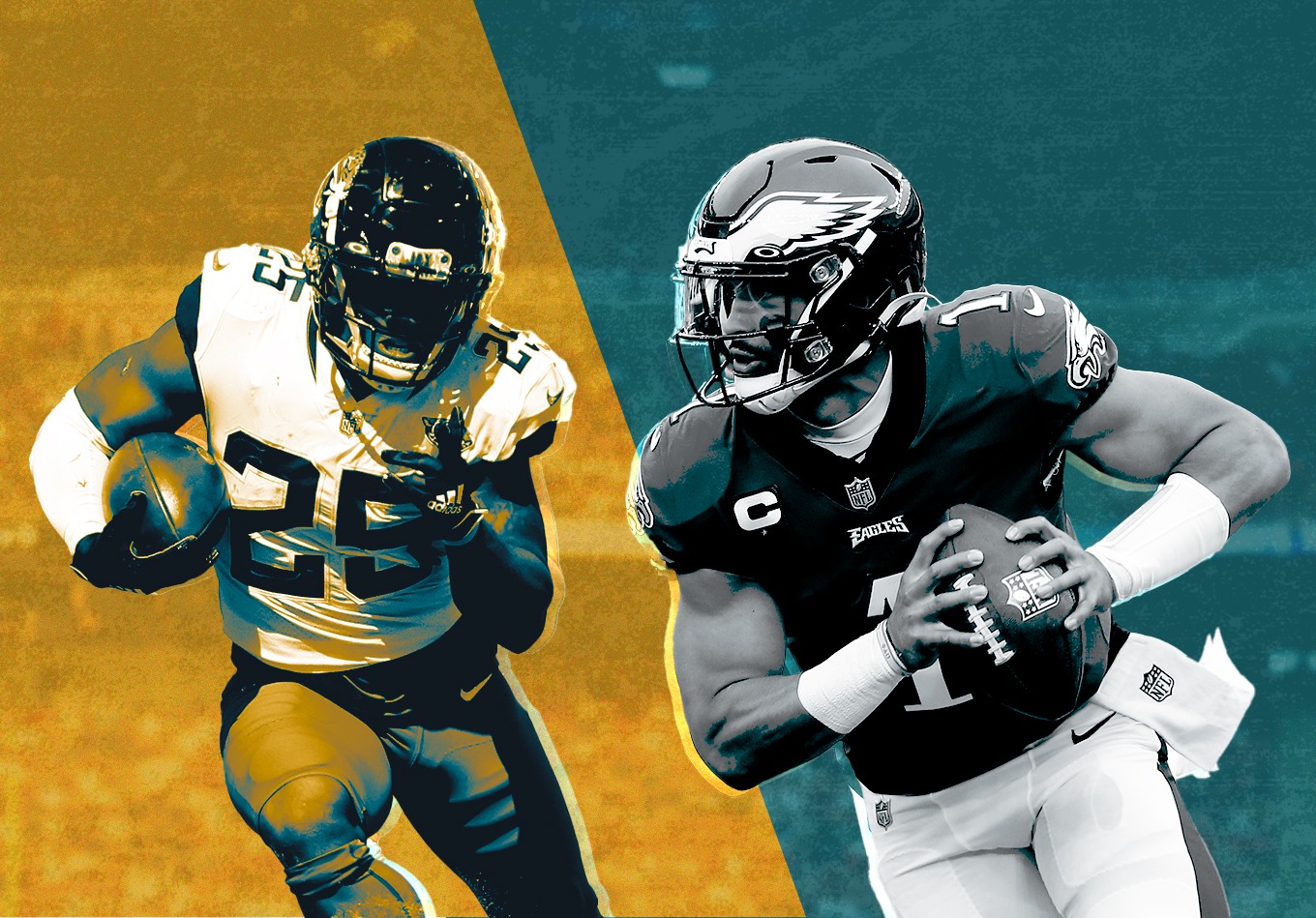There’s a buzz word that continuously pops up whenever we are describing desirable players – volume.
Volume is king. For running backs, that volume is found in carries and receptions. For wide receivers, what we really want are targets. It’s simple. The more targets a wide receiver gets, the more opportunities they have to score.
So now that we have a mostly full season behind us, let’s dig deeper. Because once we accept that volume is the single most important deciding factor to fantasy success, the next step is evaluating how efficient players are with their touches. Let’s start with running backs.
Running Backs
The reason we must split these players into position groups is because in PPR formats, the majority of touches from a running back are less valuable than a wide receiver. A 7-yard run is a highly effective real-world football play. But in fantasy terms, that play doesn’t have much standalone value – 0.7 points simply won’t move the needle.
If Player A finishes a game with 25 carries for 100 yards and Player B finishes with five catches for 50 yards, both players end with 10.0 points. This, of course, despite 20 less touches and 50 less yards for Player B.
There’s also this: Entering Week 15, the average run in the NFL in 2021 has gained 4.30 yards. The average completion has picked up 11.03 yards. In fantasy terms, that means the average run gains 0.4 fantasy points and the average reception accounts for 2.1 fantasy points.
So clearly, there is a major disparity between the average touch from a running back (usually a rush) versus a wide receiver. And now that we’ve established the difference between the two, we calculated the fantasy points per touch by every running back in the top 50 in fantasy points entering Week 15. Among all the running backs in that group with 100 touches, here were the top-10 running backs in fantasy points per touch.
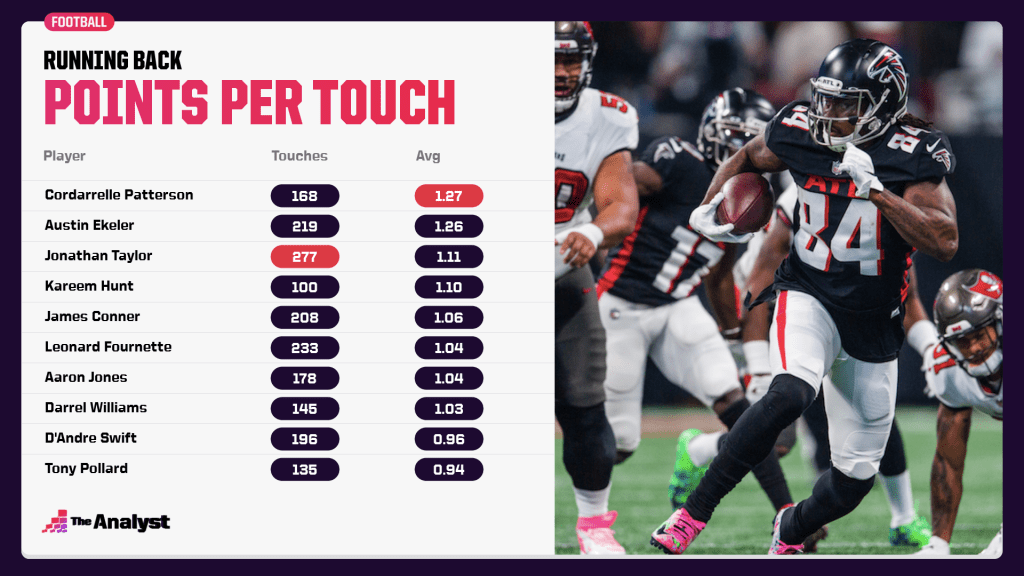
Some observations from going through this exercise with the running backs:
- The average points per touch among the top 50 running backs is 0.92.
- J.D. McKissic and Brandon Bolden actually finished tied for first overall in points per touch, each accumulating 1.41 points per touch. Which if you think about it, makes sense, because both players assume more of the pass catching responsibilities out of the backfield. Bolden, in fact, has more receptions (32) than carries (30) on the season.
- The “lead backs” in each of those offenses, Antonio Gibson and Damien Harris, both came in well below average with 0.7 and 0.83 PPR points per touch, respectively. Because they receive most of the rushes in their offenses but cede much of the passing game volume out of the backfield, both players are touchdown dependent to hit RB1 status in any given week.
- Nick Chubb is the classic example of what Gibson and Harris encounter. He cedes a large amount of the passing game volume to Kareem Hunt. As a result, he’s below average in points per touch (0.88).
- Najee Harris enters Week 15 as RB4 and it’s almost entirely because of his volume. He leads all running backs in touches with 297, which has enabled him to soar to RB4 despite only averaging 0.81 points per touch.
- In Christian McCaffrey’s historic 2019 season, he averaged 1.17 points per touch. Only five running backs are averaging more points per touch this season. In 2019, McCaffrey averaged over 25 touches per game. This year, Taylor is only averaging 21.3 touches per game. So he’s not going to come close to McCaffrey’s 2019 total of 471.2 points, despite being the benefactor of an extra game.
- Alvin Kamara finished 2020 as RB1, with a massive 1.40 points per touch average. This season, due to a massive decline in touchdowns and passing game usage, Kamara is only averaging 0.87 points per touch.
Wide Receivers
We’ll change it up slightly with wide receivers. Instead of measuring receivers against their touches, we’ll measure them against their targets. What this will allow us to decipher is who makes the most of their opportunities – their volume. Here are the top 10 wide receivers:
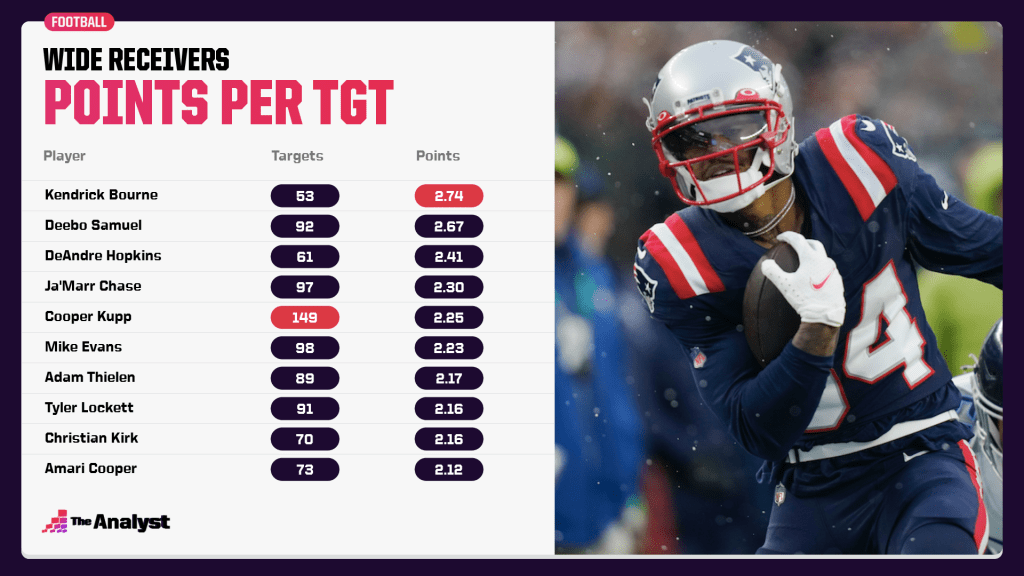
Obviously, Deebo Samuel jumps off the page with 2.67 points per target. But since he has received a significant chunk of rushing volume, he’s an outlier in this exercise. If we only calculated Samuel’s pass catching exploits, he would average 2.06 PPR points per target, identical to Justin Jefferson’s total.
Some other observations from the wide receivers:
- The average points per target among the top 50 wide receivers is 1.88.
- Kendrick Bourne has only been the recipient of 53 targets this season, six fewer than any other wide receiver in the top 50 and 37 fewer than the average number of targets for the wide receivers in this group (90.6). Despite being at such a volume disadvantage, Bourne is WR30 on the season because he’s taken full advantage of his opportunities.
- Cooper Kupp is having a historic season because he’s managed to combine the most targets in the NFL with an extremely above-average mark in points per target.
- Of the top-10 fantasy wide receivers, Diontae Johnson’s 1.69 points per target is the fewest. He makes up for it with volume, as his 130 targets are the second most in the NFL.
- Among all players with 100 targets, DJ Moore’s 1.59 fantasy points per target are the fewest.
Ultimately, this is what we search for as fantasy managers. We want players that receive tons of volume. But we also want our players to take advantage of that volume. Taylor and Kupp have done this all season and that’s why they entered Week 15 as the top two fantasy scorers.
As always, we’re breaking down our data-driven projections that use several of our AI-powered models. Here are some of our Week 15 yays and nays:
Fantasy Yays
Note: The ranking to which we compare ours in this piece is the expert consensus ranking (ECR) from Fantasy Pros. These rankings update throughout the week. (We pulled these numbers from Friday.) Once again, we are using PPR unless noted otherwise.
Additional Note: With COVID numbers spiking, there’s always a chance these players could be impacted. As of this writing, none of these players are in the health and safety protocols, though some games have been moved to Monday or Tuesday as a result of the rising cases. Fantasy managers should be ready to adjust accordingly.
Jalen Hurts, QB (PHI) vs. WSH (ECR: 8, Our Rank: 4): If volume for running backs and wide receivers are a major advantage, the same can be said for quarterbacks who can run. And boy, can Jalen Hurts run.
He ranks second among quarterbacks in rushing yards (695) and first in rushing touchdowns (8).
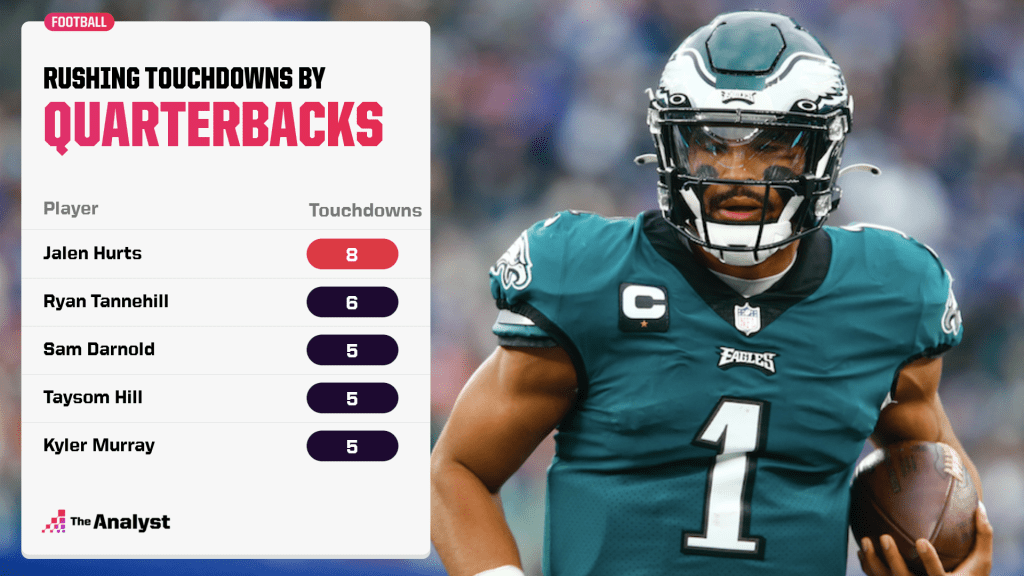
How does that translate to fantasy success? Hurts enters Week 15 as QB7 despite having the fewest passing yards of any quarterback in the top 20 in fantasy points. Facing a Washington defense that hasn’t allowed 250 passing yards in a game since Halloween, Hurts’ legs will be critical for the Philadelphia Eagles to have success.
Hurts got in a full practice on Friday, so even though he’s still listed as questionable, he’s on track to play. This game has been moved to Tuesday, so there is a chance Hurts could be a late scratch and it could be brutal for your fantasy prospects. But we expect him to go, and he instantly becomes a top-5 play.
James Robinson, RB (JAX) vs. HOU (ECR: 19, Our Rank: 5): Get this. Robinson, the breakout star of the 2020 Jacksonville Jaguars, has touched the ball a combined 15 times over the Jags’ last two games.
This week, the Jags face a Houston Texans team that allows more rushing yards per game than any other team in the NFL (147.9). Over the last two weeks, the Texans have allowed Jonathan Taylor and Rashaad Taylor to rush for over 130 yards and two touchdowns. Both Taylor and Penny finished their week as RB3.
We’re betting that Robinson won’t be sidelined for significant stretches this week. He’s projected for 18 carries this week, and against a Texans defense that has struggled to stop the run, he’s going to turn that into fantasy production. Robinson is a legit RB1 option this week.
Courtland Sutton, WR (DEN) vs. CIN (ECR: 47, Our Rank: 23): It’s been a real struggle for Sutton this year that has culminated in this current six-game stretch in which Sutton hasn’t recorded more than two catches in any of the games.
That changes this week against a Cincinnati Bengals defense that is stout against the run and vulnerable against the pass. Because it’s a big strength of the Bengals defense, teams tend to abandon the run when playing Cincinnati. Teams attempt passes against the Bengals on 64.4% of their snaps – the second-highest rate in football. The Denver Broncos usually pass on 57.1% of their snaps. With that number likely to increase against the Bengals, Sutton is in a position to benefit.
Because of his season-long lack of production, Sutton is a risky play. But our models expect Sutton to return WR2 value this week.
Fantasy Nays
Tom Brady, QB (TB) vs. NO (ECR: 3, Our Rank: 9): For all of the amazing numbers Brady has piled up while defying father time in Tampa Bay, the New Orleans Saints have been the one team he and the Buccaneers haven’t quite been able to figure out.
In three regular season games against the Saints, Brady has totaled six touchdown passes to go along with seven interceptions. And his Bucs are 0-3 against the Saints. After averaging over three passing touchdowns per game until the team’s bye in Week 9, Brady has only had one game with more than two passing touchdowns since that time.
Unlike Hurts and some of the other top quarterbacks, Brady has no value running the ball. He relies on dynamic passing numbers. Those numbers are unlikely to come in major volume against the Saints. Brady is a lower-tier QB1 for this week.
Aaron Jones (ECR: 15, Our Rank: 32) and AJ Dillon (ECR: 26, Our Rank: 35), RBs (GB) vs. BAL: During the course of the season, the Green Bay Packers backfield situation has morphed into a Cleveland-like backfield, with Jones and Dillon sharing the touches.
Jones doesn’t have more than 15 carries in a game and only has one 20-touch effort since Week 4. During that same time frame, Dillon has four games with at least 15 carries and two games with 20 touches. The problem with splitting touches is more pronounced when playing a team like the Baltimore Ravens. The Ravens are first in the NFL in rushing yards allowed per game (85.5). They also rank 31st in passing yards allowed per game (266.1) and no team has allowed more completions of 20 or more yards (56) or touchdown passes of 20 or more yards.
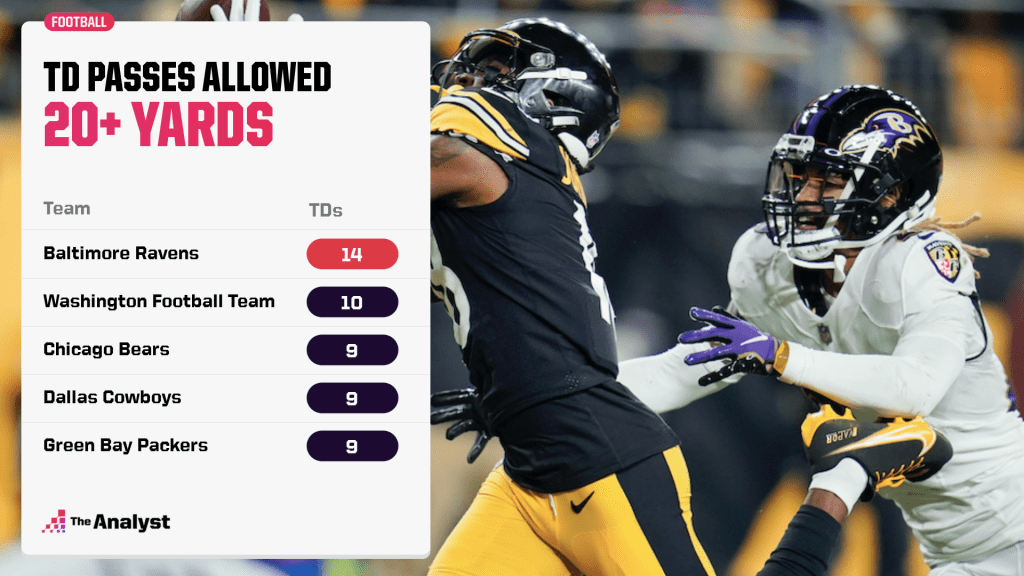
Because of the success our projections expect Green Bay to have passing the ball (347 projected passing yards), there isn’t a ton of room for the Packers running backs. They’re both flex worthy plays, but both will need a touchdown to achieve anything more than that.
Brandon Aiyuk, WR (SF) vs. ATL (ECR: 23, Our Rank: 42): One of the major reasons of the San Francisco 49ers resurgence from 3-5 to a playoff spot has been the re-emergence of Aiyuk as a real threat in the passing attack. With at least 80 receiving yards in three of his last six games, Aiyuk has recorded three top-12 finishes in his last six games.
But with George Kittle the clear No. 1 option in the passing game and Deebo Samuel commanding plenty of looks as a potential NFL Offensive Player of the Year candidate, targets aren’t one of the things that have swung heavily in Aiyuk’s favor. He’s still only averaging 6.0 targets per game over this stretch. And against a Falcons team that has struggled to stop the run, Aiyuk isn’t going to get a ton of opportunities to produce big fantasy numbers.
Our models are projecting Aiyuk for 5.8 targets, 3.5 receptions and 46.6 receiving yards. Those are pedestrian numbers certainly not worthy of low-WR2 status like his ECR indicates. He’s a risky play as the clear fourth option in that offense behind Kittle, Samuel and the run game.
Graphic design by Briggs Clinard.
